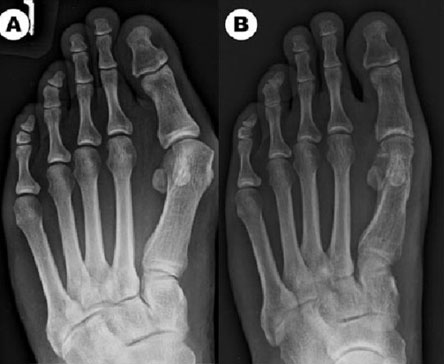Esat UYGUR, Namık Kemal ÖZKAN, Kaya AKAN, Hakan ÇİFT
İstanbul Medeniyet University Göztepe Training and Research Hospital, Department of Orthopedics and Traumatology, İstanbul, Turkey
Ersoy Hospital, Department of Orthopedics and Traumatology, İstanbul, Turkey
Medipol University Faculty of Medicine, Department of Orthopedics and Traumatology, İstanbul, Turkey
Objective: The aim of this prospective randomized controlled single-blind study was to compare the results of Chevron and Lindgren-Turan osteotomy techniques for treatment of moderate hallux valgus.
Methods: A total of 66 female patients (34 in Chevron group, 32 Lindgren-Turan group) were recruited in this study and followed up for an average of 26.08 months. Operative procedures were performed by 2 surgeons, and patients were evaluated by an another researcher who was blinded to the surgical technique. The groups were compared for their radiological and clinical results.
Results: Both techniques was clinically and radiologically effective (p<0.01). However, no significant differences were found between the 2 groups regarding American Orthopaedic Foot and Ankle Society’s clinical rating system, Painful Foot Evaluation scale of Maryland University scores, or radiologic evaluation (p>0.05). Compared to the Chevron group, the Lindgren-Turan group was found to have shorter surgical duration (p<0.05) and significantly more shortening at the first metatarsal (p<0.05).
Conclusion: In moderate hallux valgus deformity, both the Chevron and Lindgren-Turan osteotomy techniques are clinically and radiologically safe, effective, and reliable alternatives. No superiority was detected in either technique. Although shortening at the first metatarsal in the Lindgren-Turan group was radiologically significant, the results were clinically tolerable.
Keywords: Chevron osteotomy; Hallux valgus; Lindgren-Turan osteotomy; operative treatment. Level of Evidence: Level I, Therapeutic Study

